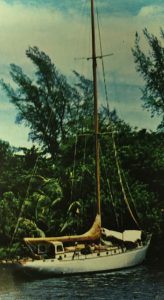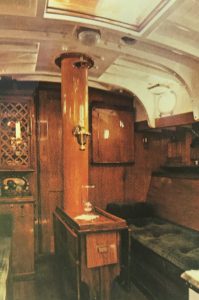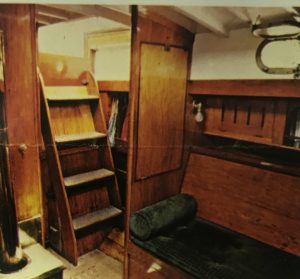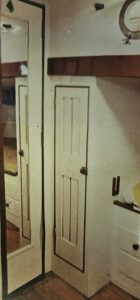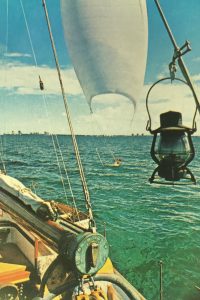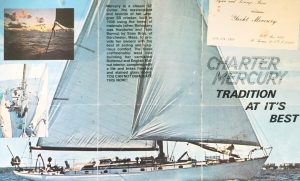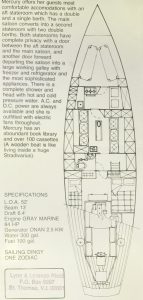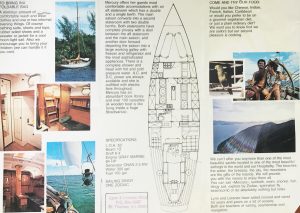
Built at the Simms Bros. Shipyard in Dorchester, Massachussets, for J.J. Storrow, she was designed by Sam Crocker. Out of his many designs Mercury is often considered as “perhaps one of his best achievements” according to Joel White, (the prestigious designer of the Class W traditional boats), as he himself states in the epilogue of the book published by Sam’s son, Sturgis Crocker, showing numerous photos and drawings of his father’s designs where Mercury bears number 191.
The boat was in principle designed for the waters of New England and Bermuda, and had one sole owner for thirty years. She then changed hands several times, and so graced the waters of different places along the eastern coast of the United States.
Photos and documents from her time spent in the Virgin Islands:
Mercury finally crossed the Atlantic for England where she stayed for some years before cruising the Spanish coastline to finally arrive in Majorca.
A letter of thanks from Lemie Lentz
Dear owner of Mercury,
Today while looking through some old papers, I found my folder advertising “Mercury” on which I crewed in the Virgin Islands years ago, when her captain was a female real estate broker, a day-sailor for tourists. I cannot remember the captain’s name. When I looked up “Mercury” online, I was so happy to read your lovely tale of her restoration/revival! Some of my fondest memories of my time on St. John, USVI were of sailing on “Mercury.” And for years I’ve wondered what had became of her.
“The sounds of her sails, the color of the water— all magic!!!”
I remember sailing through the Anegada Passage, and other shorter trips closer to St. John. I remember polishing brass for hours, drinking good wine with our small crew, and eating French cheeses after our clients left! The sounds of her sails, the color of the water— all magic!!!
Please accept my gratitude for your work, and for sparking exquisite memories.
Sincerely,
“Lemie” Lentz
Lemie McKeown Lentz (on Facebook)
New Owner restoration review(courtesy of Fundacio Hispania)
“I saw this boat in Pollensa for the first time. I had been looking for a classic boat during quite a few years, and when we met, Mercury standing dry on the dockyard and I absolutely enraptured by its lines, I knew at once that my search had come to an end, bought it right away and became its seventh owner on the line. At the time the boat was registered in Spain and bore the nice name “Dama Española”, but I knew I would restore its original name as soon as possible. All the information I have managed to collect has come under this name, the one received on being launched, and is going to be known by under my ownership.
I sailed the boat to Palma. Its outer looks were fine because it had been properly maintained as far as paint and varnish go. The most serious problems were to be found inside and concerned the structure and installations. I looked for a “mestre d´aixa ” (shipwright) and met Mateo Grimalt, the artisan who would restore the boat to its past splendour.
This restoration has been possible due to a great extent to the solid team formed by the owner, shipwrights and other that managed to create a beautiful work atmosphere with a shared purpose. I would like to underline the formidable devotion and commitment vested in the task by, besides Mateo, Siso and Javier, whom we have lived every stage of the enterprise together with . To start with we went for the hull’s structure, and after careful examination, for the ribs from the sternpost’s bottom upwards and then all the way towards the bow. Rib by rib albeit every other rib first, we detached them and replaced them with new ones, and so dealt with every suspicious looking floor and frame, all the wood work in American oak. On the other hand, the new screws were of silicon brass, like the original the most resistant and durable for wooden boats. The forepeak choke’s condition as well as the sternpost’s were so bad that we decided to have them built from scratch.
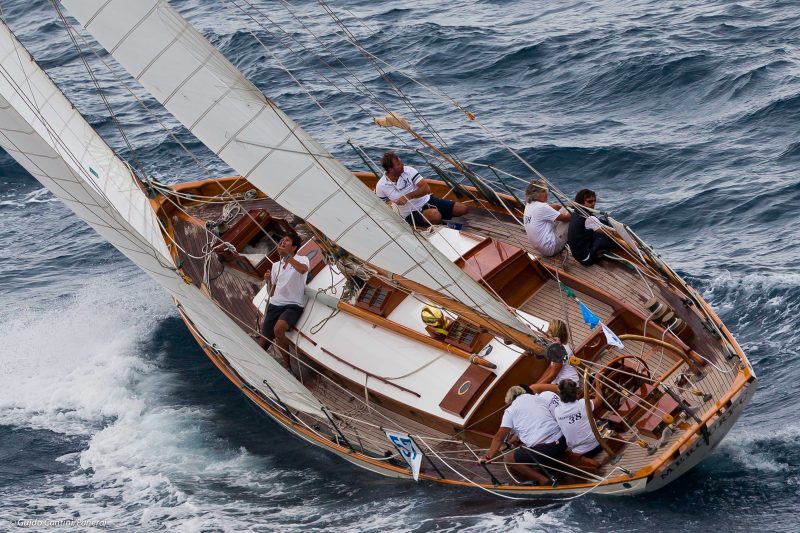
Progress was slow indeed but sure. Bit by bit the new hull’s structure was taking form while acquiring growing consistency. The next stage saw the hull’s outer finishing with mahogany, like it was originally, the first three massive planks over the keel 5 cm thick, the others 2,5 cm. The planking being double, mahogany outside and cedar inside, the hull is all in all 3,5 cm thick. Each plank was laid where it belonged, and so the thick bottom ones had to be slowly accommodated via repeated wetting and hooking them into shape day after day before finally screwing them onto place.
After due scraping up the hull became at last the painters’ job, this whole work finishing in May 2001. We had believed the deck to be alright, but a close examination proved us wrong: it had to be detached and replaced by a new one. Once the beams checked, the faulty ones were also replaced, as well as the supporting strakes and edges (oak). Then a 2,5 cm thick marine board was laid on for the whole deck to be more solid and waterproof. A new mahogany side stringer and gunwale were put to place with brass screws. All the cabin’s reinforcements were carefully checked and replaced by new ones. Finally a new Burma teak 1,5 cm thick deck was laid on by José Luis Grimalt . There followed the coating with paint, and since we did not want to use any putty as it becomes friable with time and eventually falls down, we filled in all irregularities with paint and assorted plugging if necessary in order to make the hull as smooth as possible.
By September we were ready to tackle the inside. Thus, we fixed all the bulkheads from the bow backwards, adjusting them millimetrically to the hull while scrupulously respecting the original design. We installed the new engine and generator, the water tanks, and fuel’s as well as all the tubing needed for the water supply and the electric or electronic wiring. Mercury is really unique on account of the enormous natural luminosity within, this being rather uncommon in vintage boats. Besides its twelve portholes we must mention its three large skylights that provide both a very good ventilation and plenty of light. Another feature contributing to the luminosity is the rather light colour of the wood panelling quite opposed to the usual dark walnut-like wood used time ago in Europe. We used cherry wood for the inside, not only for it was closest to the original, also because it matched so well with those ivory-coloured dovetailed bulkheads so typical of American construction. The floors are in Oregon pine wood, and the whole setting creates a nicely warm and welcoming atmosphere. Progress was also made on the outside: last coat of paint, finishing touches on the deck, and first scraping of mast and boom to the highest degree of smoothness.
Anecdotically I shall recall that there is a legend that tells that in past times a gold coin was placed in every newly built boat as token of good luck. From the very start of our works on Mercury and as we were approaching their end we kept saying that sooner or later we had to bump into it. One day while toiling on the mast I found a coin-sized metallic piece at the first crosstree’s height. Covered with varnish I took it to be but a little plate bearing the name of the mast manufacturer, but some polishing revealed the truth: it was a Peruvian “sol de oro” gold coin. I leave it to you to judge whether this has any meaning.
It was time to broach other aspects of the boat’s equipment, i.e. rigging and sails. And our decision was to entirely renew them both, the sails to be made by the prestigious British Ratsey-Lapthorn Company, Cowes (England). Mainsail, Genoa gib, staysail, two Yankees, big and small, the latter for strong winds, and a traditional spinnaker. The work inside the boat went briskly on, and planks and bulkheads were duly varnished and painted. Little by little did our ultimate goal get closer: to have Mercury back in the water before the hot weather came. We set a launching date.
The last days saw a frantic activity with all of us running to and fro with materials, parts, tools, screws, cans, etc. We wanted to have Mercury ready for the “Almirante Conde de Barcelona” regatta in August, this being both our main challenge and stimulus since we could not think of a better scenario for presenting the boat. Come launching day, the 21st April, and we had all gathered full of expectations, though we first had to do away with the plastic tent and scaffolding that had virtually been our home for the last nineteenth months.
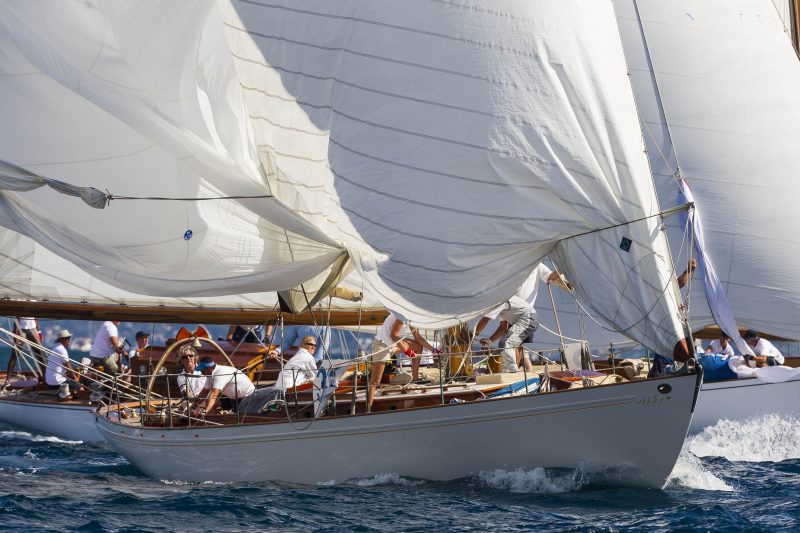
At last we could look at our boat from many different angles and distances. And quite honestly I was marvelled. It was a very special day for all of us, that is, my family and all who had intervened in the restoration. There was very little left to do: a few touches to the mast to have it ready to be placed next day once the boat was afloat, the very last moves to collect a few tools still around and to clear out the area. The boat was gently lifted and taken to the launching pit wherefrom slowly regained its natural environment amidst looks of affection and admiration. Beauty and poise altogether, and all in order. We all jumped aboard and toasted for the days ahead. My relatives, mestres d’aixa, electricians, you name it, we all celebrated that special moment. A few odd painting jobs inside still took a while that we used to good effect for checking once and again our winches, deck fittings, stanchions, cleats, etc. No single detail was left unattended in that marvel of a boat we had all grown to love without limit. Heidi, my wife, took care of all the boathold details: water taps, crockery, upholstery, drapery and wardrobe. Her choice and good taste gave Mercury a very warm, cozy atmosphere.
And so came the much longed for day. What a fantastic sensation as Mercury had its sails hoisted, took a slight list and glided along the water. It lasted but a few hours, but believe me I cannot describe the pleasure we surely shared with the boat after such a long time of inactivity. Our Trofeo Conde de Barcelona rendez-vous was getting closer and we could not help going again through every possible detail to make sure that everything was alright. The boat entered, the expectation was great for it was widely rated amongst the boats likely to be awarded the prize for the best restoration job. This was our first racing experience, and there could not have been a better occasion than this celebrated regatta in the waters of the Bay of Palma. An how we enjoyed it. Mercury and its crew behaved extraordinarily, and this gained us two trophies, for “best restoration” and “best ambiance”, respectively, we are both proud of and happy at seeing our efforts so well acknowledged. There are many other little things and anecdotic issues I have not detailed because the real motivation for this article is none other than bear witness of what we did, and can be done by any future owner of a classic boat eager to be put to sea where she belongs.”

